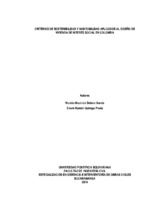Mostrar el registro sencillo del ítem
Criterios de sostenibilidad y habitabilidad aplicados al diseño de vivienda de interés social en Colombia
| dc.contributor.advisor | Director. Remolina Millan, Aldemar | |
| dc.contributor.author | Solano García, Nicolás Mauricio | |
| dc.contributor.author | Quiroga Prada, Edwin Ramón | |
| dc.coverage.temporal | 2014 | spa |
| dc.date.accessioned | 2022-10-21T14:54:12Z | |
| dc.date.available | 2022-10-21T14:54:12Z | |
| dc.date.issued | 2014-09 | |
| dc.identifier.uri | http://hdl.handle.net/20.500.11912/10326 | |
| dc.description | 89p.: (pdf); il; imágenes; anexos. | spa |
| dc.description.abstract | Cuando se habla de vivienda de interés social, son muchas las posibilidades y también los paradigmas. Es común enfrentar hoy flagelos de hacinamiento por área construida, consecuencia de la prelación a la cantidad y no a la calidad. En este trabajo se planteó un modelo de vivienda de interés social; sin embargo, al explorar una posible metodología que permitiera llegar al producto final ya mencionado, se encontró con la incertidumbre respecto a los caminos para diseñar. Se plantea entonces, una nueva metodología que permitiera llegar a la vivienda con criterios de sostenibilidad y habitabilidad como producto final. Esta se hizo mediante fases y escenarios, agrupando cada escenario hipotético en cinco fases compuestas de diferentes componentes que estructuraron el enfoque de un proceso de diseño sólido a través de un flujo direccional en orden lógico y por escenarios de estudio, que abordan distintas dimensionas de la vivienda. En ese orden de ideas, se planteó un producto final que lograra una relación de apropiación y pertenencia con quien lo habita, procurando la tan anhelada calidad residencial (habitabilidad) y así mismo, responder a las necesidades de sostenibilidad del mundo actual, asociando esta, a la forma y estructura de la envolvente, fomentando desde los proyectos de interés social nuevas prácticas sostenibles. Finalmente, se propuso una forma de evaluar tales criterios convirtiéndolos en indicadores de ponderación que permitieran determinar de forma cuantitativa una respuesta a la pregunta ¿Qué tan sostenible y habitable es la vivienda que se diseña? Al terminar la ponderación de la matriz usada para evaluar parte del diseño planteado, se determinó que aunque se implementaron parte de las estrategias propuestas, el diseño sigue mostrándose “crudo”; invitando a nuevos investigadores a continuar con la implementación de nuevas estrategias en el diseño para aumentar los porcentajes de los indicadores de sostenibilidad y habitabilidad. | spa |
| dc.description.abstract | When social housing as topic is taken, there are many possibilities and paradigms. Today is common the issues of overcrowding by building area, a result of the priority given to quantity and not quality, increase. In this paper a model of social housing was raised; however, at the moment to make an exhaustive list of possible methodology to reach the final product that was mentioned, he found uncertainty about the ways to design. So, was of vital importance, propose a new methodology to reach the housing habitability and sustainability criteria as a final product. This was done through phases and stages, gathering each hypothetical scenario in five phases composed of different components that structured the approach of a solid design process through a directional flow in a logical order and by means of study scenarios that address the different dimensions housing. In that vein, it was suggested a place and not a space; ie the final product designed achieve a relationship of ownership and belonging with who inhabits, ensuring the long-awaited residential quality, and also, respond to the needs of environmental sustainability in the current world, linking this to the form and structure envelope, encouraging from social projects, new sustainable building practices. Finally, a way to evaluate such sustainability and habitability criteria was proposed, making them become to indicators of weighting. According to this, is possible determine quantitatively answer to the proposed question, ¿How sustainable and how habitable is housing that is designed? After the weighting matrix used to evaluate of the proposed design, it was determined that, although implemented part of the proposed strategies, the design continues to display "raw"; inviting new researchers to continue with the implementation of new strategies in the design to increase the percentage of indicators of sustainability and livability. | en |
| dc.format.mimetype | application/pdf | spa |
| dc.language.iso | spa | spa |
| dc.publisher | Universidad Pontificia Bolivariana | spa |
| dc.rights | Attribution-NonCommercial-NoDerivatives 4.0 Internacional | * |
| dc.rights.uri | http://creativecommons.org/licenses/by-nc-nd/4.0/ | * |
| dc.subject | Selección de hábitat | spa |
| dc.subject | Viviendas de interés social | spa |
| dc.subject | Bioclimatología | spa |
| dc.title | Criterios de sostenibilidad y habitabilidad aplicados al diseño de vivienda de interés social en Colombia | spa |
| dc.type | Especialización | spa |
| dc.publisher.department | Escuela de Ingenierías | spa |
| dc.publisher.program | Especialización en Gerencia e Interventoría de Obras Civiles | spa |
| dc.type.hasVersion | publishedVersion | spa |
| dc.description.sectional | Bucaramanga | spa |
| dc.description.degreename | Especialista en Gerencia e Interventoría de Obras Civiles | spa |
Ficheros en el ítem
Este ítem aparece en la(s) siguiente(s) colección(ones)
-
Trabajos de grado [6698]
Monografías, artículos, informes, proyecto de grado


